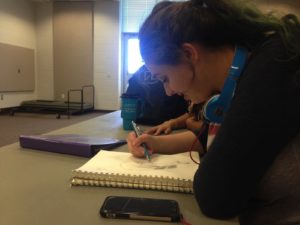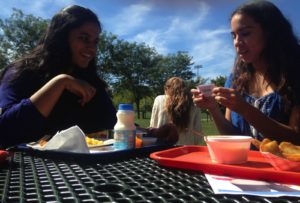By: Maura Longenecker
Testing isn’t only used to show intelligence; it also demonstrates memory retention.
Testing is one way of seeing memory retention, or the ability to remember, in action. Retaining information affects everyone. After all, everyone can retain information using their senses at any time, but they can’t always trust their long-term memory. There are several methods that can help with retaining information. Additionally, those that have problems with memory retention can be helped through routines that become habits.

Pete Steelman, a psychology teacher at Hershey High School (HHS), had a way of looking at memory retention. Steelman said that just repeating or staring at the material to memorize it won’t help retain the information for long. Instead, Steelman suggests that the more senses people use while studying or learning, or the more they use their brain, the longer people will remember what they were learning.
“If the info is ‘attached’ to a visual, a physical game, or a song, it’s actually being stored using multiple mediums in the brain, and thus it ‘sticks’ better,” said Steelman. Steelman gave the example of using vocabulary words to make a story or drawing images of the parts of a cell, so the students are using more than one sense.
As well as connecting to information, Steelman said that another way senses play a role in memory retention is through a theory called “State Dependent Memory.” This theory states that when people are studying or learning, their brain takes in all of the senses, such as lighting, feeling, hearing, etc., and connects it to the information.
“So all those little environmental elements are attached to the (information), and they serve as ‘triggers’ to recalling the info later,” Steelman said.
Steelman went on saying that people will remember the information best when the “environmental elements” are closest to the ones they learned the information in.
Aside from environmental elements, there are teaching methods that can improve memory retention. Steelman added methods of memory retention, some that can be used for studying. These included creating mnemonic devices, repeating information, and attaching a visual image to the information. “Any time you can incorporate multiple senses in the memory, it will stick better.”
Michelle Kindt, a French teacher at HHS said, “I want the students to really know what it is that I teach them.” Kindt teaches keeping what she knows about memory retention in mind. Kindt said that she teaches less information, so her students could have a deeper and longer-term understanding of what they learn. “I want to learn things more fully, and understand things more fully.”
Some other things Kindt does includes using gestures, context such as reading and stories, and repetition. However, Kindt believes that the most important thing in memory retention is for the material that she taught to be meaningful or relevant to her students in some way.

Julee Brown, a Special Education Teacher at HHS, uses a couple of other memory retention methods in her teaching. Brown uses visuals to help retrieve memories more easily as well as using words and muscle memory. Brown focuses on, “creating those routines” in her students’ minds.
Aside from methods of recollection for the average person, Brown deals with those who have a harder time with memory retention, and she said how she helps. Primarily, Brown said that people learn through routines that form habits. These habits eventually lead to the students not having to think step by step anymore.
Brown does a lot of physical practices of going through routines to enforce muscle memory, so it helps to get that visuals in their heads and to get it to stay.
“Then it becomes muscle memory, routine.” said Brown, “if you can connect to something, it can have more meaning and you can think deeper about it.”
This is her philosophy when it comes to teaching her students. Brown said that if teachers can tie information into something the students already know, they can connect to it better.
“You want them to connect so it’s not just rote memory,” Brown said.
That doesn’t mean that Brown walks her students through everything, though. Brown connects memory a lot with problem-solving. “If I have to figure it out or problem solve myself, I have a deeper understanding and memory of how to do it the next time.”
Brown also believes that part of learning is through trial and error, making mistakes. Her job is to help her students, but also to coach them through doing things and solving problems themselves.



